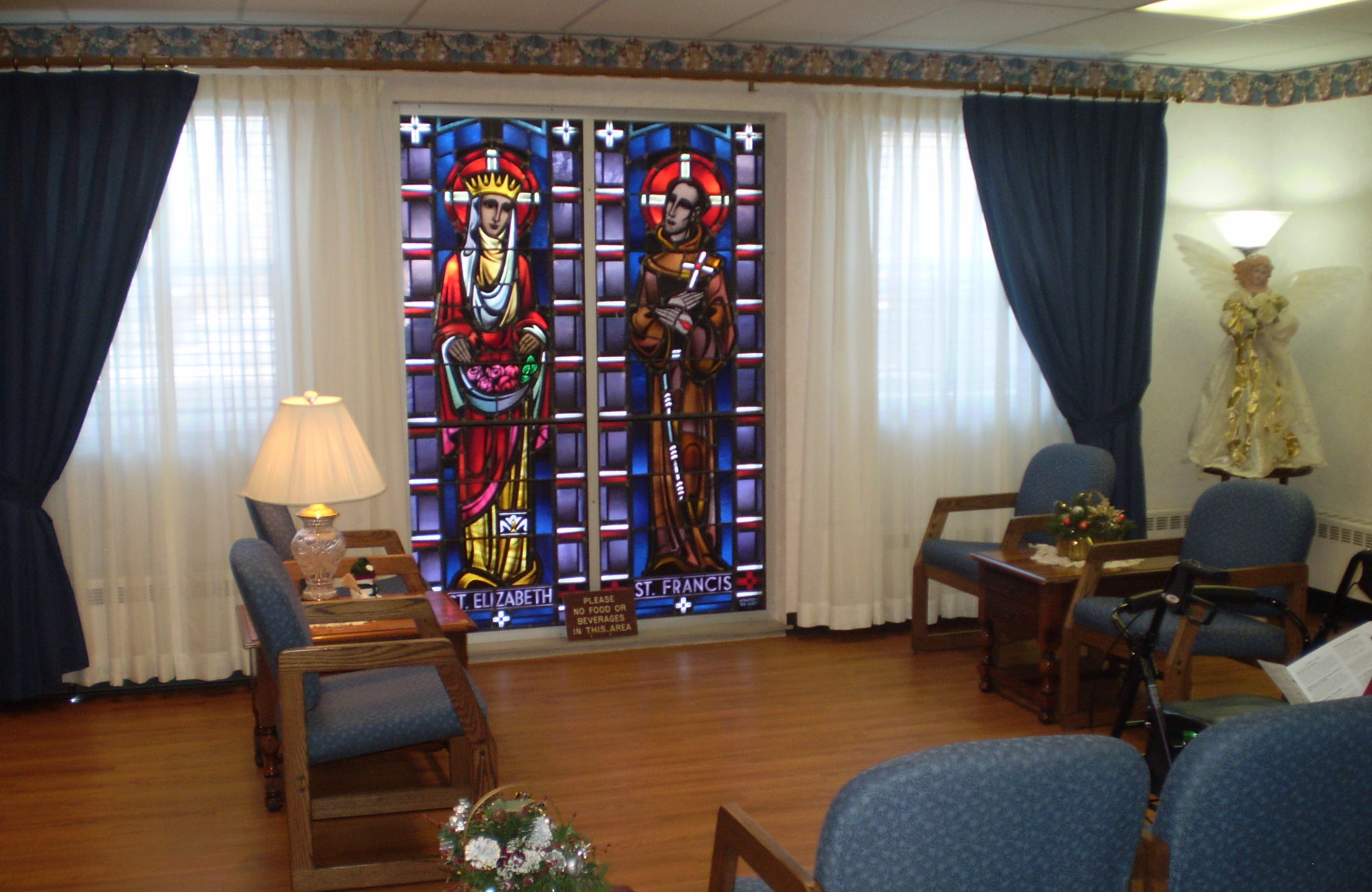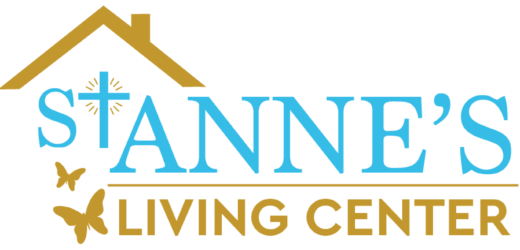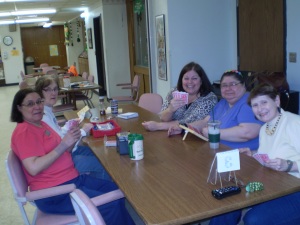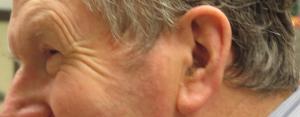We had some fun with our resident newsletter, The Broadcaster, this month; we claimed that April Elves got a hold of our computers so the front and back pages are full of fun, made up articles of news from St. Anne’s. If you haven’t seen it already, check it out! If you’d like to get our newsletter via email on a monthly basis, please let us know; it is normally not available online. Below is a preview of the first page.
Spring has sprung with spring cleaning fun!
Little did I know on Friday, when I decided to scrub the floors, that it was National Cleaning Week. Because many of the floors at our convent are waxed, I didn’t want to use my favorite vinegar-water, for fear of removing the polish. Instead I used warm water with a splash of dish soap. I’ve learned that there are lots of different products one can use for the same thing, and just as many theories about which is better. An article on Mother Nature Network provided an interesting, comprehensive breakdown of the various cleaning solutions. I’d encourage you to visit that site, as it offers the pros and cons in a clear and helpful manner.
One of our volunteers at St. Anne’s, Kathy Lieberg, has more information to share. She’s learned about home-made cleaning products, which she appreciates because you “can avoid harsh chemicals and save money.” She finds that “they work wonderfully!”
Kathy shared with me a sampling of just some of the many homemade cleaners that can be made using ingredients you probably have on hand; I’d like to pass this information on to you.
“OxyClean Cleaner”
1 part baking soda
1 part peroxide
2 parts water
CarpetCleaner
1 cup peroxide
a few drops of Dawn soap
Orange/Vinegar Cleaner
Fill a quart jar with orange peel. Add white vinegar to top – let stand 2 weeks and drain into sprayer. Save your orange peels in a bag in the freezer until you have enough to fill a quart jar.
All in a good night’s sleep – Tips for Healthy Sleeping Habits
 As I begin compiling this blog post, I am in the middle of working another night shift at St. Anne’s. I enjoy night work and am glad to help out in this way when needed. However, someone recently commented that doing this “isn’t very healthy.” I begged to differ that an occasional night shift isn’t the end of the world; it’s better to be available when there’s a staffing problem than to selfishly say “I need my beauty rest.” However, I realize that healthy sleeping habits are important and deserve consideration, especially as people age. In this article, I’d like to share with you some of what I found about healthy sleeping habits, especially for seniors. How much sleep do you get? How much do you need? I’ve wondered this myself. According to an article on senior sleep habits (sited later in this article), “most healthy adults tend to require between seven and a half to nine hours of sleep per night to function at their best.” They did note, however, that needs vary for different individuals. According to helpguide.org, “consistently going to sleep and rising at the same time leaves people feeling “much more refreshed and energized.” They suggest resisting the urge to stay up late and sleep in on weekends. They even suggested napping to compensate for missed zees, rather than sleeping in late. However, this same site warned about the dangers involved in napping, with the risk of causing insomnia. Not napping too late in the day, and also limiting the nap to 30 minutes are a couple of ways of reducing this risk. An article by the Mayo Clinic also stresses the importance of maintaining a sleep schedule. This same article suggests limiting naps. It also shares some helpful information about the two types of sleep: non-rapid eye movement — or NREM sleep — and rapid eye movement — or REM sleep. NREM sleep…We cycle through the NREM-REM stages of sleep approximately every 90 minutes.” (The deepness of sleep depends on this.) The helpguide article shared that one important factor in sleeping ease and sleepiness is exposure to light. To help with alertness, increase your exposure to light and take advantage of daylight outdoors. On the other hand, when you’re trying to fall asleep, don’t use the TV or computer, as these can hinder your ability to sleep. I’ve even heard it said that a person should not use the computer for an hour before going to bed as it may cause difficulty in falling asleep. Avoiding bright lights, both before bed and when getting up at night, is also suggested. Following a set bedtime routine is another way of helping your body get into “sleep mode.” Some examples include: reading a book or magazine (using soft light), taking a warm bath, listening to soft music, making little preparations for tomorrow, and winding down with a hobby. Some of these same practices can be applied if you wake in the middle of the night. Keeping your bedroom free of noise and also at a comfortable temperature also can help. You don’t want it too hot or too cool, as this can make sleeping difficult. Another thing that can keep you from sleeping is worrying; there may be a lot that has to be done the coming day. Although some people offer relaxation exercises, why not try something as simple as making “to-do list.” A time of prayer before bed, entrusting these and other worries to our Lord, is a great way to conclude the day that is past and prepare for sleep. (Check out my article on Our Franciscan Fiat for an explanation on doing a daily examen in the evening.) This can be a helpful bedtime “ritual.” Another article by this same source (helpguide.org) shares information more specific to seniors: It is noted that changes in sleep patterns (earlier sleeping and waking and less deep sleep) are normal. Insomnia, however, is not to be accepted as part of aging. In fact, good sleep is important for seniors for helping with concentration and memory; it also lets your body repair cell damage and “refreshes your immune system. Actually, if you are a senior who doesn’t sleep well, you are more suseptable to “depression, attention and memory problems, and excessive daytime sleepiness [as well as] more nighttime falls [and] increased sensitivity to pain. Also, you’re likely to “use more prescription or over-the-counter sleep aids.” This same source about seniors also noted that “insufficient sleep can also lead to…an increased risk of cardiovascular disease, diabetes, weight problems, and breast cancer in women.” An article by the Sleep Foundation also pointed out that people tend to have a harder time falling (and staying) asleep as they age. Although seniors still need the same sleep, they tend to have less deep sleep (including less REM sleep). Consequently, they may need to spend a longer time in bed to get the quality sleep they need. This source also pointed out that insomnia is more frequent among seniors. According to the helpguide article, one issue at hand in senior sleep needs is the fact that your body makes less growth hormone as you age, leading to lessening of deep sleep and melatonin production. According to Mayo, seniors may also be more sensitive to noise and environmental factors, which may hinder sleep. While all this is normal, there are some causes of insomnia in older adults that we should note. The leaders among these include:
As I begin compiling this blog post, I am in the middle of working another night shift at St. Anne’s. I enjoy night work and am glad to help out in this way when needed. However, someone recently commented that doing this “isn’t very healthy.” I begged to differ that an occasional night shift isn’t the end of the world; it’s better to be available when there’s a staffing problem than to selfishly say “I need my beauty rest.” However, I realize that healthy sleeping habits are important and deserve consideration, especially as people age. In this article, I’d like to share with you some of what I found about healthy sleeping habits, especially for seniors. How much sleep do you get? How much do you need? I’ve wondered this myself. According to an article on senior sleep habits (sited later in this article), “most healthy adults tend to require between seven and a half to nine hours of sleep per night to function at their best.” They did note, however, that needs vary for different individuals. According to helpguide.org, “consistently going to sleep and rising at the same time leaves people feeling “much more refreshed and energized.” They suggest resisting the urge to stay up late and sleep in on weekends. They even suggested napping to compensate for missed zees, rather than sleeping in late. However, this same site warned about the dangers involved in napping, with the risk of causing insomnia. Not napping too late in the day, and also limiting the nap to 30 minutes are a couple of ways of reducing this risk. An article by the Mayo Clinic also stresses the importance of maintaining a sleep schedule. This same article suggests limiting naps. It also shares some helpful information about the two types of sleep: non-rapid eye movement — or NREM sleep — and rapid eye movement — or REM sleep. NREM sleep…We cycle through the NREM-REM stages of sleep approximately every 90 minutes.” (The deepness of sleep depends on this.) The helpguide article shared that one important factor in sleeping ease and sleepiness is exposure to light. To help with alertness, increase your exposure to light and take advantage of daylight outdoors. On the other hand, when you’re trying to fall asleep, don’t use the TV or computer, as these can hinder your ability to sleep. I’ve even heard it said that a person should not use the computer for an hour before going to bed as it may cause difficulty in falling asleep. Avoiding bright lights, both before bed and when getting up at night, is also suggested. Following a set bedtime routine is another way of helping your body get into “sleep mode.” Some examples include: reading a book or magazine (using soft light), taking a warm bath, listening to soft music, making little preparations for tomorrow, and winding down with a hobby. Some of these same practices can be applied if you wake in the middle of the night. Keeping your bedroom free of noise and also at a comfortable temperature also can help. You don’t want it too hot or too cool, as this can make sleeping difficult. Another thing that can keep you from sleeping is worrying; there may be a lot that has to be done the coming day. Although some people offer relaxation exercises, why not try something as simple as making “to-do list.” A time of prayer before bed, entrusting these and other worries to our Lord, is a great way to conclude the day that is past and prepare for sleep. (Check out my article on Our Franciscan Fiat for an explanation on doing a daily examen in the evening.) This can be a helpful bedtime “ritual.” Another article by this same source (helpguide.org) shares information more specific to seniors: It is noted that changes in sleep patterns (earlier sleeping and waking and less deep sleep) are normal. Insomnia, however, is not to be accepted as part of aging. In fact, good sleep is important for seniors for helping with concentration and memory; it also lets your body repair cell damage and “refreshes your immune system. Actually, if you are a senior who doesn’t sleep well, you are more suseptable to “depression, attention and memory problems, and excessive daytime sleepiness [as well as] more nighttime falls [and] increased sensitivity to pain. Also, you’re likely to “use more prescription or over-the-counter sleep aids.” This same source about seniors also noted that “insufficient sleep can also lead to…an increased risk of cardiovascular disease, diabetes, weight problems, and breast cancer in women.” An article by the Sleep Foundation also pointed out that people tend to have a harder time falling (and staying) asleep as they age. Although seniors still need the same sleep, they tend to have less deep sleep (including less REM sleep). Consequently, they may need to spend a longer time in bed to get the quality sleep they need. This source also pointed out that insomnia is more frequent among seniors. According to the helpguide article, one issue at hand in senior sleep needs is the fact that your body makes less growth hormone as you age, leading to lessening of deep sleep and melatonin production. According to Mayo, seniors may also be more sensitive to noise and environmental factors, which may hinder sleep. While all this is normal, there are some causes of insomnia in older adults that we should note. The leaders among these include:
- Poor sleep habits and sleep environment [with] irregular sleep hours, consumption of alcohol before bedtime, and falling asleep with the TV on
- Pain or medical illness, including need to urinate, arthritis, asthma, diabetes, osteoporosis, nighttime heartburn and menopause
- Medications
- Lack of exercise
- Psychological stress or psychological disorders, including anxiety or sadness
- Sleep disorders
- Learned response – due to some cause (e.g., grief), you get in the habit of not sleeping, which persists even after the initial cause is gone.
Conversely, this article also shared some tips to help you get a good night’s sleep:
- Activity: social, work, volunteer, and family
- Exercise regularly. This can help with mood and reduce stress, depression, and anxiety. Also, if you’ve worked hard by exercise, you’ll be more ready to sleep well.
- Limit caffeine, alcohol, and nicotine (stimulants that interfere with the quality of your sleep)
- Minimize liquid intake before sleep
Caffeine Awareness Month
Compiled by Retired Nurse, Kathy Neumann
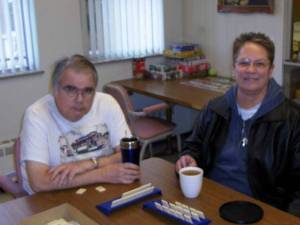 St. Anne’s Guest Home serves de-caffeinated coffee for our residents, but maybe caffeine isn’t so bad after all! Coffee gets a bad rap, but studies show this habit can actually be good for you. People who drink a cup or two have a lower skin cancer risk, and coffee may also help fight cavities.
St. Anne’s Guest Home serves de-caffeinated coffee for our residents, but maybe caffeine isn’t so bad after all! Coffee gets a bad rap, but studies show this habit can actually be good for you. People who drink a cup or two have a lower skin cancer risk, and coffee may also help fight cavities.
“Coffee is incredibly rich in antioxidants, which are responsible for many of its health benefits,” it may play a protective role in some health conditions, whether you go for decaf or regular.
You may be surprised to learn that coffee can also decrease your odds of developing a stroke by 25%. It also reduces the risk of diabetes because it is rich in minerals of magnesium and chromium, which may help control blood sugar levels. Stress can be reduced by coffee. People with a family history who drink coffee are less likely to develop the debilitating neurological disease. Coffee drinkers also have a reduced risk of Alzheimer’s, Parkinson’s, Type II diabetes and many other diseases.
Also, in one study, women who drank a cup of coffee more than four times a day had a reduced risk of breast cancer. Also, mouth and throat cancers were found to be 40% less in people who drank four or more cups daily. An important point: unfiltered coffee contains up to 80 times as many coffee-specific fatty acids, which have been linked to slower growth of cancerous cells. Heart disease can be lowered also by this bad habit.
But, enough about coffee – here’s some more information about caffeine in general…
One can feel the effects of caffeine in as little as 10 minutes, and makes one most alert after 45 minutes and may last up to 3 to 5 hours.
Bees also love caffeine, and it helps their brains too!
However, people with certain health issues, such as high blood pressure or high blood sugar, are encouraged to limit their caffeine intake. Overdoing it with caffeine can lead to interrupted sleep or even insomnia, stomachaches, a racing heart, nervousness, irritability, and nausea. Cappuccinos add a lot of calories to your coffee and can actually raise your risk for diseases like stroke and diabetes.
Resources:
http://www.everydayhealth.com/diet-nutrition/0310/9-healthy-reasons-to-drink-coffee.aspx
http://mic.com/articles/84925/14-surprising-facts-about-caffeine-explained-by-science
Card party, anyone – Seniors benefit from ‘the shuffle’
On multiple levels, card playing can be very beneficial for seniors. Playing card game with others, along with having the value of brain stimulation, have the added bonus of social interaction. Our activities staff often play cards with residents. When I work the front desk here in the evenings, I also offer residents the opportunity to stop by for some games of cards. We used to have quite the crowd that would come, necessitating the use of a card table pulled up to the desk and chairs and a stool gathered from all parts of the office. More recently, less people have been coming, which is really too bad since card playing is very beneficial for mental and social stimulation.
Games which stimulate the mind, according to Boomers-with-elderly-parents.com, may slow various forms of dementia.
Furthermore, this same source shares that “games involving acuity, concentration and focus enhance the brain’s capability to utilize and stimulate brain cells, electrical connections and keep neural pathways open and functioning.”
Along with card games, board games, logic and crossword puzzles, etc. can help with mental and cognitive functions, to which helps with reasoning, problem solving, memory, processing and concentration.
According to an article by Stephanie Henkel, “decline in brain power…can be slowed by exercising our brains and challenging our new brain cells with a variety of stimulating activities.” Another interesting point she makes is that “just as our bodies need physical exercises and training to keep fit, so our brains need to be exercised…”
Actually, games that require more skill and strategy are better, such as pinochle, bridge or canasta, according to this same source. Making a periodic effort to learn new games is also suggested, however, I have learned that some people simply often don’t have the motivation or mental capacity for this. One of my favorites doesn’t do a ton for brain stimulation, but is good to keep you moving physically, and that is “spoons.”
Another article on the benefits of card playing adds some additional considerations:
“Cards are portable…” Also, along with the mental advantages, playing cards can help people “improve their fine and gross motor skills” and hand-eye coordination. Another point this article shared is that “shuffling and dealing may help quicken your reflexes.” For those who lack the dexterity, as they age, to hold all their cards easily, I’ve seen rack devices where they can place their cards and which can be very helpful.
Ideas Welcome
I’d love to hear from you about topics that you’d like to see covered on “The St. Anne’s Scoop.” If you have ideas to share, please send me an email at: [email protected] – or write a reply/comment here. Thanks for getting “The Scoop!”
How much do you know about pretzels?
 This article was originally published on March 3rd on my blog for our Religious Community, “Our Franciscan Fiat.”
This article was originally published on March 3rd on my blog for our Religious Community, “Our Franciscan Fiat.”
Did you know that pretzels are a Lenten food? Their shape is meant to resemble arms crossed in prayer or penance. Catholicculture.org has some interesting information about them. They may be made using the simple ingredients of flour, yeast, water, and salt, not requiring eggs, milk or butter (which in times past had been forbidden during Lent).
This past week, along our St. Anne’s Activity Director, Shelly, I made soft pretzels for our residents’ afternoon snack after bingo. Before this, our residents’ favorite pastime, Shelly read to them about the spiritual history of these “little arms” (Latin: bracellae) We had fun throughout the games, joking about pretzels. I especially enjoyed picking on (in fun) one of our ladies who could live on pretzels. We even went so far as to have them call out “pretzel” instead of bingo.
In all seriousness, the sight of a pretzel can serve as a reminder to me and you of the call to prayer and penance, especially during Lent.
Sr. Christina M. Neumann, OSF
PS: I usually wear that goofy hat when I call bingo, but that’s a whole other story!
Homemade Soft Pretzel Recipe
1 and 1/2 cups warm water
1 packet active instant yeast (2 and 1/4 teaspoons)
1 teaspoon salt
1 Tablespoon granulated sugar
4 cups flour
coarse sea salt for sprinkling
Directions:
Dissolve yeast in warm water. Mix all ingredients except coarse salt. Knead dough well. Let rest and raise for ½ hour. Make long ropes and shape like pretzels.
Preheat oven to 375. Boil for 30 seconds or more in a bath of baking soda and water(about ½ c. soda to 8 c. water). Sprinkle with coarse salt. Bake on cookie sheets at 375 for 25 min. or until nicely golden. You can serve them warm, and even add cinnamon and sugar.
March is International Listening Awareness Month – 15 tips for good listeners
As we observe this month, I have to share a humorous story from the med. line at St. Anne’s. We Sisters eat supper across from the nursing office and often hear the comments and conversations of residents who are in line. One evening, over a year ago, two ladies (both hard of hearing) really gave us cause to chuckle. After several minutes of unsuccessfully trying to get a message across to her comrade, the other lady finally shouted “Do you have trou-ble with your hear-ing?” I guess you kind of had to be there, but we still laugh about it to this day.
Having good hearing definitely has its advantages, but, regardless of one’s auditory acuteness, we can all try to be good listeners. Serving at St. Anne’s, this month is a good reminder to me of how important it is to truly listen to people, to take the time to be attentive. Sometimes, I find that I am busy, yet a person needs my attention. This Listening Awareness Month is another reminder to me to stop (when possible) and really listen to our residents, regardless of my other priorities. Whatever your situation may be, I’d like to encourage making the time and effort to listen to others.
15 key points for good listening:
http://www.sitepoint.com offers some excellent advice.
- First, stop talking.
- Stop everything you’re doing and listen.
- Use “inviting body language” – tell them by your posture that you’re open and listening (uncross your arms, face the person who is speaking, nod, etc.)
- Don’t be planning out what you will say next.
- Be open-minded and avoid passing judgment on the speaker.
- Put yourself in the other person’s shoes.
- Don’t interrupt.
- Get clarification for a better understanding of what was said. An informative article from the Chicago Tribune offers other insights:
- Focus on the other person, not on you’re thinking…Absorb the feedback…be sure you are really taking in the information the other person is giving you.
Another helpful sight on being a good listener further suggests that “active listening is blocked by your inward thinking, open out and look at the problems from the other person’s perspective.” Furthermore, “by being a good listener this can also help you become better friends with the person by getting to know more about them.” I think many of our people here can really use a good friend, one who listens. The article offers a cute, but poignant comment: “Remember that you have two ears and one mouth for a reason…you should be listening more than you are talking.” Some more helpful tips they offer are:
- Use eye contact to show that you’re interested.
- Avoid comparing the person’s experiences to your own.
- Absorb what they’re telling you; try to remember what they’re saying.
- Show them you were listening: the next time you see the person, follow up with a question about what they told you before.
- “Put aside your own needs, and wait patiently for the other person to unfold their thoughts at their own pace and in their own way.”
- Avoid saying “I” or “me” a lot. This is a good indicator that you’re focusing more on yourself than on the person’s situation.
Gotta love peanut butter – Gracie does!
Did you know that peanut butter’s good for more than PB&J sandwiches? Growing up, we used to hide pills in peanut butter to get my dog to swallow them; my parents heard this trick somewhere. Since then, we’ve discovered that it works well for the St. Anne’s yellow lab, Gracie, as well. In fact, yesterday, I was using peanut butter to clean a stubborn spot of the table, and Gracie followed her nose.
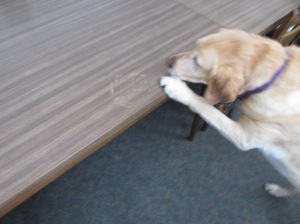
You see, peanut butter is a great multipurpose cleaner (see below)
Sometimes you’re all out of a common product, but peanut butter will do the trick. Also, it’s a more affordable alternative to some products. Here’s a list of handy uses for George Washington Carver’s masterpiece. Peanut butter may be used as:
- Shaving cream
- Leather cleaner
- Mouse trap bait
- Ant bait (2 t. peanut butter, 1/2 t. baking soda, and 1 t. of borax)
- Odor eliminator [(e.g., fish) Put a tablespoon of smooth peanut butter in the frying pan (once your dinner has been taken out!) and fry it for a minute or two.]
- Squeak eliminator (instead of WD-40 on squeaky hinges or drawers)
- Lubricant (e.g.,on lawn mower blades, saws, etc.)
- Gum remover
- Glue remover
- Price sticker removal
- Windshield cleaner (bug spot remover)
- Wood scratch repair (on wooden furniture, doorjambs, bannisters, etc.). Put peanut butter on the scratch and let it soak in for 30-60 min. Rub it away with a cloth and the scratch will be almost impossible to see!
- CD/DVD scratch repair (for a CD or DVD that keeps skipping, or won’t play, rub a little smooth peanut butter onto the scratch and wipe it away with a soft, dry cloth.
- Bird feeder (Cover pinecones with peanut butter, roll them in birdseed, and hang them up in your yard. Watch the birds come stock up on food this winter!)
- Butter substitute (in cooking)
- Moisturize your hair (Follow it up with shampoo, and be amazed at how shiny your hair can be.)
(These suggestions were taken from: http://www.lifehack.org/articles/lifestyle/21-surprising-uses-for-peanut-butter.html)
Coming up….National Chili Day (February 26)
By Sister Christina Neumann
A visitor to our Home recently commented to our residents about having to “put up with institutional” cooking, but I really don’t think that applies at St. Anne’s. Among other things, we have some of the best chili around. As we approach “National Chili Day,” I thought I’d give a little information about this delicious meal and share a recipe.
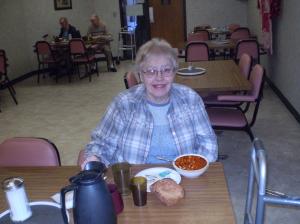 People have been enjoying chili for a long time; The first recorded recipe for chili con carne was in 1519 (nationalchiliday.com quoted Wikipedia for this info.). Did you know that “a green chili pod has as much vitamin C as six oranges?” And, what is there, better than chili, for opening up plugged sinuses?
People have been enjoying chili for a long time; The first recorded recipe for chili con carne was in 1519 (nationalchiliday.com quoted Wikipedia for this info.). Did you know that “a green chili pod has as much vitamin C as six oranges?” And, what is there, better than chili, for opening up plugged sinuses?
According to an article on the health benefits of chili, “the main component in chillies is a chemical called Capsaicin, which…lowers blood sugar levels, improves heart health, boosts circulation and protects against strokes…” Chilies also “can help burn fat.” Chili powder itself has some interesting health benefits listed here. It a good source of vitamin A and C as well as some important minerals, according to livestrong.com.
I’ve been enjoying chili for years. We used to make it back home. The recipe used here at St. Anne’s would probably make you a much bigger batch than you’d care for (we serve a lot of people), so I’m sharing with you the “Neumann Chili Recipe.” I had to contact my mom for details, since I remember just throwing it together without any real recipe.
